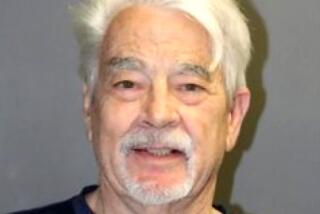The Silicone Folly
- Share via
The sign marking the studio parking lot read, fairly subtly, “36-D.”
God knows who might have stopped by if it said “Breast Men.” Probably more than just the cast and crew for the HBO movie of that title, which recently finished filming in Sylmar.
“Breast Men,” medical jargon for the plastic surgeons who specialize in bosom amplification, traces the rise and fall of the silicone gel breast implant over 30 years. The black comedy is, in the words of screenwriter John Stockwell, a “boom-to-bust story.”
“I look it as ‘Tucker’ with breasts,” Stockwell said. “It’s really a story about an inventor who came up with this, really believed in his invention and was stuck with the tragedy of wondering if what he had invented was, in fact, hurting people.”
On the set, David Schwimmer was playing doctor. As the younger of two plastic surgeons--fictionalized versions of the real breast-implant pioneers--the “Friends” star sported “Brady Bunch”-era sideburns. Dressed in a wide tie and goldenrod lab coat for this 1973 scene, he was giving a potential patient the soft sell on silicone implants:
“Now I want you to understand all your options. You can go in through the crease, which is under the breast, through the nipple or under the arm.
“We can give you a teardrop-shaped breast or a fuller, melon-shaped breast. We can make the nipples point up or out.
“And there is no real maintenance. It’s not like changing tires where you have to rotate them every 10,000 miles. But you will have to massage them frequently--preferably at home, not at work [small laugh]--left to right, top to bottom. Any questions?”
The brief monologue captures much of what “Breast Men,” which will air on HBO in October, is about: how the doctors thought implants were safe, how they confidently believed they could give every woman exactly the breasts she desired. As Schwimmer joked later in his trailer, in his best Oscar Goldman voice: “We have the technology.”
And it didn’t even cost $6 million.
At the implant peak of the 1980s, plastic surgeons charged $4,000 to $6,000 to put in implants. Some could perform nearly 20 operations in a day. And suddenly everyone--every woman at least--was a potential patient. An estimated 1 million to 2 million women paid their way into a larger bra size.
As a student at Beverly Hills High, Schwimmer said, he saw plenty of instant busts. And in Hollywood? “It’s staggering.”
Equally astonishing was his trip through the office of a local breast man who worked as a technical consultant on the film. The doctor gave him and co-star Chris Cooper a quick tutorial, from waiting room to operating room.
“It’s like shopping,” said Schwimmer, who was particularly struck by the wide selection in implant size, shape and texture.
He got to see most models in action. In scenes of parties and strip clubs--not to mention operations and consultation--Schwimmer was surrounded by a string of bare-chested women. But he quickly got desensitized. At one point, actress Emily Procter said to him: “So, this is like the fifth set of breasts you’ve fondled today.” His response: “Oh. Yeah.”
The pairing of Schwimmer, a sitcom star, and Cooper, best known for serious parts in John Sayles’ “Matewan,” “City of Hope” and “Lone Star,” appears counterintuitive. Cooper, however, called it good casting. The two doctors are an unlikely team, he said: a mentor and medical resident whose power balance is upset.
“And that’s supported in the script as you see their relationship develop. They’re pressed to form this partnership. There’s always that friction. . . . If all this hadn’t happened--the implants and everything--[my character] would’ve been perfectly happy continuing as a surgeon at Baylor,” Cooper said, referring to the Houston-based university and its College of Medicine.
Cooper, who spent part of his childhood in Houston, said he had some good models for his character: His father, a doctor of internal medicine, was at Baylor for several years during Cooper’s childhood. Cooper told his mother, in fact, that she could be in for a shock. “Some of these scenes where I’m in a lab coat very much remind me of my father.”
But it was Cooper’s wife--a strong feminist--whom he consulted before signing on to play a breast man. The script got her stamp of approval, he said. “She thought it was a very important story to tell.”
To say that silicone gel breast implants are a touchy subject grossly understates the issue. The controversy over their safety has resulted in continuing medical studies, congressional hearings, a ban by the Food and Drug Administration, a multibillion-dollar class-action lawsuit and the 1995 bankruptcy of manufacturer Dow Corning. That’s without scratching the surface of the sociocultural questions regarding why women get them in the first place.
It was a perfect topic for HBO.
Director Larry O’Neil, who previously made the low-budget theatrical feature “Throwing Down,” remembers his response to the script: “I thought you could only make this for HBO. No studio is going to make this movie. It’s just too edgy.”
Like HBO films that have come before (“Barbarians at the Gate,” “The Positively True Adventures of the Alleged Texas Cheerleader-Murdering Mom”), “Breast Men” takes the approach that truth is stranger--and often funnier--than fiction. And with a solid cable subscriber base, no advertisers to boycott and no tickets to sell, it’s a risk HBO can easily take.
The only real concern erupted over scripted “breastimonial” segments that punctuate the narrative. In some, women dropped the names of reportedly augmented celebrities. The actresses, though, were all in the implant closet, so the references were deleted.
Stockwell didn’t blame HBO executives for avoiding ruffling the feathers of stars they might want to work with later.
“I fault society for wanting [big breasts], but not being willing to know what it takes to get them,” he said.
John Matoian, president of the network’s movie divisions, HBO Pictures and HBO NYC, grants that the $8.2-million film is sardonic. But that didn’t excuse the network from showing some empathy.
“The concern we had was that we made sure we were sensitive to the issue and the women in the film. We didn’t want to parody or disparage or show any disrespect to the women, who according to the movie got taken for a ride by these doctors,” Matoian said.
Still, HBO’s examination won’t be as earnest as, say, “Two Voices,” an original movie that Lifetime aired Monday. (It airs again tonight at 8, Wednesday at 9 p.m. and Saturday at 8 p.m.) That film lauds the activism of Sybil Niden Goldrich and Kathleen Anneken, who waged a campaign against silicone gel implant manufacturers. The pair founded the Command Trust Network and testified to Congress and the FDA about their post-implant health problems.
If anyone might object to a comic treatment, it would be Goldrich. But to the contrary, she said there’s an emperor’s-new-clothes aspect to the whole thing that could be very funny. After so many years, she said, the story is finally ripe.
“There is a very dark, cynical side to issues involving breast implants,” Goldrich said. “When you look at it from anything but the patient’s point of view, you see that there had to be almost a conspiracy of silence because of the vast amount of money involved. . . . I certainly hope this writer understood the satire that could be derived from the cynicism that goes into making a product and then not telling anyone that it doesn’t work.”
*
A Texas Monthly article snagged Stockwell’s interest. In among the anecdotes from patients and surgeons, lawyers and litigants was a picture of the two doctors, Thomas D. Cronin and Franklin J. Gerow, who patented silicone gel implants and arguably revolutionized plastic surgery.
With little more than a bare outline, Stockwell went to HBO and made his pitch: a darkly humorous film that chronicles the history of the breast implant as seen through the doctors who created it. Ultimately, he made them fictional characters so he had more dramatic liberty. His doctors became Everybreastmen who embodied the qualities of several surgeons--like the one with the breast-shaped swimming pool.
“I went into it with no ax to grind, no preconceptions. I’m not party to any lawsuits. I have no agenda,” he said. “I was just really curious.” He read articles in medical journals; their terminology still cracks him up. “Micromastia” for small breasts. “Pototac,” he said, “which I think means droopy.” One 1970s paper discussed how a small-breasted woman’s “feminine currency may be devalued in her own view and in that of her male companions.” Venus de Milo was the ideal.
Stockwell went to Houston, where the implant was developed and many subsequent lawsuits filed, to do research. He interviewed women who had chosen to have implants.
“Under the guise of being a screenwriter, it’s amazing how many women you can get not just to talk about their breasts but to show you their breasts,” he said. Houston doctors too were willing to open up their offices.
“The first guy I went to see . . . he drags me into the operating room. I wasn’t wearing scrubs. He had some girl on the table who was completely naked and sort of half-conscious,” Stockwell recalled. “It was very easy access. I remember she was awake during the operation. And that first one was a belly-button boob job, which was really bizarre. They put a tube though your belly button and sort of excavate up. Then they roll up the saline implant to the size of tobacco leaf, and the tube is still coming out the belly button and then they inflate the implant through the tube. And she can say, ‘More on the left. More on the right. Bigger. Smaller.’ ”
Stockwell saw a lot of “swapping out” surgeries--trading silicone implants for saline ones. The same doctors who made a fortune putting in silicone implants are now making more money--usually paid by insurance companies--replacing them. That irony, and others, were not lost on Stockwell.
The script, however, stays neutral, he said. Or it is at least an equal-opportunity offender.
*
Emily Procter pulled out two boxes, each about the size of a children’s shoe box. “These,” she said, “are my $700 boobs.” Well, that’s how much they would cost to buy. Hers were rented.
She took one out of the box and flopped it back and forth in her hand, amused. The clear sac filled with tan-colored gel, complete with a stick-on nipple, fit between her breast and bra and filled her out for her post-implant scenes.
“When I have these in, boy, I tell you, wow, I feel like a woman,” Procter said. “But I also love that I can come in my trailer and take them out. I can put on a tank top and not worry about it. I can jog and not have to wear four bras.”
That sets her apart from most of the other women in “Breast Men.” Producers and casting agents found about 60 full-figured women for party and strip club scenes. It was easy, said executive producer Gary Lucchesi. “Believe me, it’s not that difficult to find dancers with augmented breasts in this city.” Producer Guy Riedel concurred: “In almost every case, the interviewers were more embarrassed about the nudity than the women were. They were very matter-of-fact about it.”
The real difficulties came in finding women who had to be seen both pre- and post-implants. Stockwell suggested finding actresses who would be willing to have the implants at HBO expense; others thought that was a sick idea. Riedel determined that it also would be impractical. The women couldn’t be filmed, have the implants and fully recover before the end of the 34-day shoot.
In the end, the male producers learned what women have known for centuries: The right clothes can hide most anything.
Gelatin prosthetics were used to show deformation from 1950s-era foam implants and ruptured silicone sacs. For nude shots of Procter’s before-and-after miracle, they used a body double whose chest will be digitally implanted onto Procter’s.
*
If only it were that easy in real life.
A cramped operating room built on the sound stage gave a closer sense of what the real process is like. Schwimmer, in bloody scrubs, circled Procter on the operating table. He rehearsed his surgical moves like a basketball player practicing a free throw, committing them to muscular memory.
In the scene, the doctor sized up his work, admiring it in a very Pygmalion-esque way: Later in the film, he marries this patient.
“What do you think?” he asked the nurse.
“Beautiful.”
“They’re not too small? You don’t think we should’ve gone with 350 CCs?”
“They’re perfect,” the nurse said. “They should be; you spent three hours on them. Do you want me to close?”
“No, no. I’ll do it. I don’t want even a hint of a scar.”
In her trailer just before filming, Procter explained the scene: “The irony is in ‘perfect.’ She ends up getting lupus.”
It’s interesting, she added, that this movie about breasts is dominated by men. And appropriate.
“Were there no men on the planet, would women still get breast implants?” she said. “Probably not.”
Yet this issue that seemed so clear to her personally--she likes her nearly-B-cups just fine, thank you--became a little more complex during the shoot. Why should she judge women who have breast implants? After all, she has her vanities. She highlights her hair, dyes her eyelashes, puts on lipstick.
“What’s the difference?” she asked. “That it’s under your skin?”
“Breast Men” doesn’t try to sort it all out. The movie is not a history lesson, Stockwell said, nor an agent of blame. Women got sick. Companies went belly-up. The doctors--Cronin and Gerow--were named in countless lawsuits. Both died prematurely. In the end, there was enough vanity--and tragedy--to go around.
More to Read
The complete guide to home viewing
Get Screen Gab for everything about the TV shows and streaming movies everyone’s talking about.
You may occasionally receive promotional content from the Los Angeles Times.






